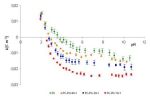EPJ E Highlight - Ion adsorption matter in biology
- Details
- Published on 28 October 2014

New systematic study of the electrical properties of model lipid membranes could improve our understanding of biological cells and opens new possibilities for medical diagnostics
Biological membranes are mainly composed of lipid bilayers. Gaining a better understanding of adsorption of solution ions onto lipid membranes helps clarify functional processes in biological cells. Now, a new study provides a quantitative description of the equilibria between lipid membranes and surrounding solution ions. Joanna Kotyńska and Zbigniew Figaszewski from the University of Bialystok, Poland, are the authors of a study describing these findings, just published in EPJ E. In addition to shedding some light on biological processes, these results could also have implications for, among other things, the future development of medical diagnostics.
In the study the authors used liposomes, which are spherical vesicles with membranes consisting of lipid bilayers encapsulating water-based media. These are a popular model system for biological membrane studies because the liposome membrane composition can be easily varied. The focus of the study is the adsorption of solutions ions onto liposomal membranes. The adsorption process modulates a range of the membranes’ physicochemical and electrical characteristics. It is therefore important in multiple processes involving membranes in the living cell such as, for example, in the membrane transport mechanism. Using a technique called microelectrophoresis, the authors observed changes in the membrane electric charge caused by the adsorption of ions such as sodium, chloride, hydrogen and hydroxide.
Based on experimental results, Kotyńska and her colleague developed a theoretical model of interactions between these ions and liposomal membrane surfaces. They subsequently verified this model experimentally. They then determined the association constants characterising the membranes’ functional groups interaction with ions. By defining the value of these parameters they were able to calculate model curves. This, in turn, enabled them to validate their model by comparing model curves with experimental data.
Microelectrophoretic investigation of the interactions between liposomal membranes formed from a phosphatidylcholine-phosphatidylglycerol mixture and monovalent ions. J. Kotyńska, Z. A. Figaszewski (2014), Eur. Phys. J. E 37: 92, DOI 10.1140/epje/i2014-14092-3





